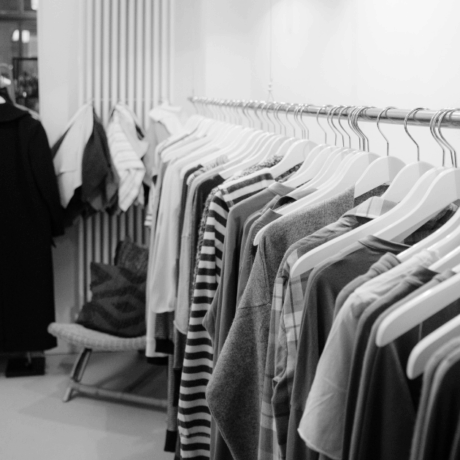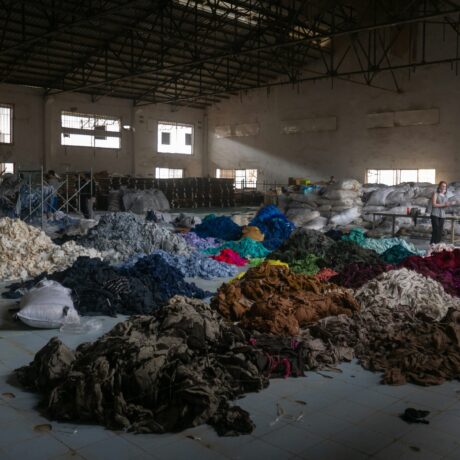Fashion’s Invisible Footprint: How Microfibres Ripple Through our Ecosystems
From ocean pollution to everyday laundry, synthetic textiles are fueling a global plastic problem, but it’s not too late to make a difference.
Plastic is everywhere, even in our clothes. Nearly two-thirds of garments today are made from fossil-fuel-based synthetics such as polyester, nylon, acrylic, and elastane—and many of these fibres end up in our oceans.
This was explored by UK photographer Mandy Barker, who spent a decade documenting synthetic fragments drifting along the UK coastline. At first glance, her images resemble seaweed or algae, but they’re actually pieces shed from our clothes. Her work offers a striking reminder that plastic pollution has infiltrated marine ecosystems. If this continues unchecked, both ocean life and human health face serious consequences.
And these are just the plastics we can see. Every day, invisible microplastics slip into waterways through garment production and laundry.
What’s the microplastic problem?
Microplastics are fragments smaller than 5mm, and synthetic textiles are one of their main sources. These tiny particles are easily ingested, accumulating in marine animals and even humans—though the long-term health effects are still being studied.
Researcher Subramanian Muthu explores in his book Sustainable Fashion: Consumer Awareness and Education (2019) how the 1950s saw an increasing demand for fast and cheap fashion, leading to a reliance on synthetic textiles. These textiles are significantly cheaper and easier to produce than natural fibres, allowing for quick turnaround in response to the increasing demand from consumers and profit-driven companies for more clothing. In 2024, it was revealed that Australia was the number one fashion consumer per capita (followed by the USA and UK), buying an average of 56 new clothing items a year. As demand increases, so too does production, and at an increasing rate. Fossil-fuel-based textiles increased in output from 67 million tonnes in 2022 to 75 million tonnes in 2023, and less than one per cent of the global fibre market comes from recycled textiles.
Overproduction and overconsumption have led to pressure on our ecosystems, and even washing our clothes made from synthetic material damages marine environments. In fact, it’s estimated that washed textiles could contribute up to 34.8% of the 1.5 billion tons of primary microplastics released each year, posing threats to marine life and human health.
Where are we in 2025? Is Recycling the Answer?
While some brands have begun to incorporate recycled polyester into their collections, this doesn’t tackle the actual problem, and the majority of recycled polystyrene comes from plastic bottles, not other garments. The result is continued production of non-biodegradable garments, which contribute to microplastic pollution in oceans and rivers.
In 2022, the United Nations proposed a legally binding agreement to tackle the global plastic crisis — recognising microplastics as part of the problem and calling for a full life-cycle approach to plastic production. The full resolution can be read here.
Three years later, and with the sixth round of negotiations concluding in August 2025, countries are still split, and no agreement has been proposed. The dividing line between countries is whether the treaty should tackle plastic production at its source, or focus on managing the pollution plastic creates. Oil-producing countries argue that fossil fuels are a vital part of future economies and that the focus should be on waste management and recycling programs. Ross Eisenberg, President of America’s Plastic Makers, unsurprisingly, also advocates for continued production with a focus on tackling plastic pollution through more recycling initiatives.
Better waste management is essential, but for fashion, the priority must be tackling plastic at its source. Profit-driven systems make this difficult; environmental protection rarely aligns with the interests of those benefiting from overproduction.
Small Changes You Can Make at Home:
Even if the UN can negotiate a treaty, the fact is that there is still no blueprint or guidance on what that would mean for the fashion industry, would production halt? Or would billion-dollar corporations find a loophole?
While countries and corporations need to step up to tackle plastic production at its source, there are also small changes we can make with big impacts for marine and human health.
Importantly, this doesn’t mean we should discard the synthetic clothes we already own, as keeping them in use for longer remains the most sustainable option. But we can care for them in ways that reduce microplastic pollution. You can:
- Buy a Guppyfriend bag for washing your clothes – it collects the microplastics and prevents them from entering the waterways.
- Install a washing machine filter – the Australian Government’s National Plastics Plan aims to require filters in all new machines by 2030, but for now, it’s up to households to take initiative.
- Adjust your washing habits – If buying a Guppyfriend bag or filter isn’t possible, even simple changes like washing on a lower speed and temperature can help.
- Choose natural fibres when buying new – opting for natural, unprocessed fibres (like organic cotton) means the garment can return to the earth rather than remain as microplastics forever.
Even these small shifts can make a measurable difference. Changing the way we wash and care for our clothes helps protect marine ecosystems—but we must also push for systemic change.
The fashion industry needs policy, regulation, and accountability to match the scale of the crisis. Until then, every individual action counts.
Follow Fashion Revolution Australia to stay updated on new research, including our newly released report, What Fuels Fashion?, uncovering the true energy and environmental costs of what we wear.
Web Resources
- Textile Exchange Materials Market Report 2024 https://textileexchange.org/knowledge-center/reports/materials-market-report-2024/
- Textile Exchange Preferred Fiber & Materials Market Report 2022 https://textileexchange.org/app/uploads/2022/10/Textile-Exchange_PFMR_2022.pdf
- BBC article on UN Plastic Pollution Treaty https://www.bbc.com/news/articles/cvgpddpldleo
- Australian Institute Research on Fashoin Consumption https://australiainstitute.org.au/post/australians-revealed-as-worlds-biggest-fashion-consumers-fuelling-waste-crisis/
- UNEP Microplastics Brochure https://wedocs.unep.org/bitstream/handle/20.500.11822/12079/brochure-microplastics.pdf?sequence=1&%3BisAllowed=
- Mandy Barker Photography https://www.mandy-barker.com/atkins-barker
Academic Resources
- Cullen, M. (2024). The New Sea Food: Fashion, Waste, and Microplastics. Southern Cultures, 30(4), 64–75. https://doi.org/10.1353/scu.2024.a951662
- Muthu, S. Senthilkannan (Ed.). (2019). Sustainable Fashion: Consumer Awareness and Education (1st ed.). Springer Singapore. https://doi.org/10.1007/978-981-13-1262-5
- Wang, C., Song, J., Nunes, L. M., Zhao, H., Wang, P., Liang, Z., Arp, H. P. H., Li, G., & Xing, B. (2024). Global microplastic fiber pollution from domestic laundry. Journal of Hazardous Materials, 477. https://doi.org/10.1016/j.jhazmat.2024.135290








